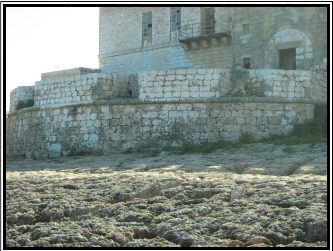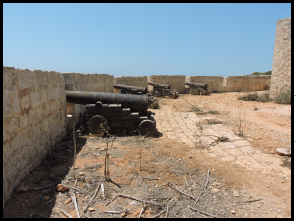Wied Musa Battery
Wied Musa Battery was one of those fortifications built in the early 18th century. The building of coastal batteries was a new concept of fortifications which was initiated by the French in France and their colonial possessions. Although the concept was the same only a handful of coastal batteries similar to those of the French were built. The majority of those built in Malta had a semi-circular platform, two blockhouses and a redan.
Wied Musa Battery was not an exception. It was a large battery compared to others built in the Mellieħa area. Commander Mongontier donated one third of the sum needed for the construction of Wied Musa Battery, meaning 250 scudi out of the 938.1.8 scudi. The work on it began in 1714 and was finished two years later. Part of the expenses went on works on each five muri a due facciate, which costed 102.2.2 scudi, 28.7.13.4 scudi, 196.0.12.3 scudi, 65.8.16.2 scudi and 31.0.13 scudi respectively, the terraze, pittaforma e ballate costed 118.1.17.3. scudi.

A front view of Wied Musa Battery with the semi-circular battery and the 19th century structure additions.

A close-up of the battery with three of the four embrasures for the cannons.

A typical gun platform of a coastal battery showing four 6-pdr cannons in their embrasures. This particular example is found at Comino Battery
The battery consisted of a large semi-circular gun platform, surrounded by a parapet, with four embrasures for cannons. Behind the semi-circular wall there are still partially visible, two blockhouses one on either side, with a redan at the back joining both blockhouses. The redan formed the landward defence in case of an attack from the land, fitted, with a number of musketry loopholes for the soldiers stationed in it to defend the rear approaches to the battery. It is surrounded by a ditch.
On 4 October 1769, the Congregation of War made a report about the actual situation in the coastal fortifications, in terms of artillery pieces. The report showed how the coastal fortifications of Mellieħa had been depleted in regarding artillery pieces. The following is the situation found in Wied Musa Battery:
Wied Musa Battery
There were four 8-pdr cannons, but now is disarmed, and the utensils remain for the cannons that was armed with.
A year later, an artillery inventory was made in the Mellieħa coastal batteries, and we know that there were the following items as Swatar Battery or Wied Musa Battery as was more commonly known:
Swatar Battery
Iron cannons 8-pdr = 4
Naval carriages = 6
Iron cannon balls 8-pdr = 280
Canister shots 8-pdr = 60
Blackpowder conserved at St. Agatha Tower = 1.94
An artillery inventory was prepared by the Knight St. Felix on 3 October 1785, which showed the situation in the same coastal fortifications and how many pieces of artillery and other utensiles and necessary items they had. The following is the list of artillery pieces in Wied Musa Battery:
Wied Musa Battery/Swatar Battery
Iron cannons 8-pdr = 4
Naval carriages = 6
Iron cannon balls 8-pdr = 280
Canister shots 8-pdr = 60
On November 1792, the Congregation of War ordered that guards to be sent to Wied Musa Battery:
Wied Musa Battery
16
In the 19th century the battery was extended and another floor was built to be used by the governor as a summer residence.
Wied Musa Battery
9